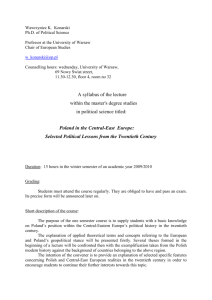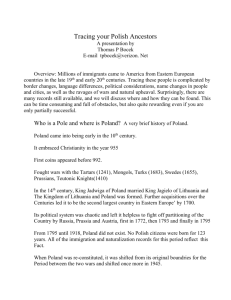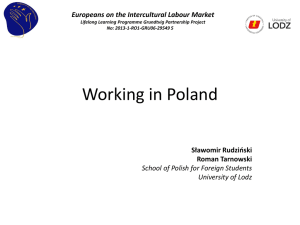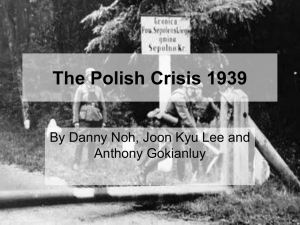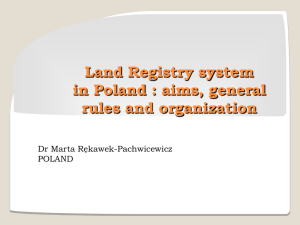Poland 1918-1939
advertisement
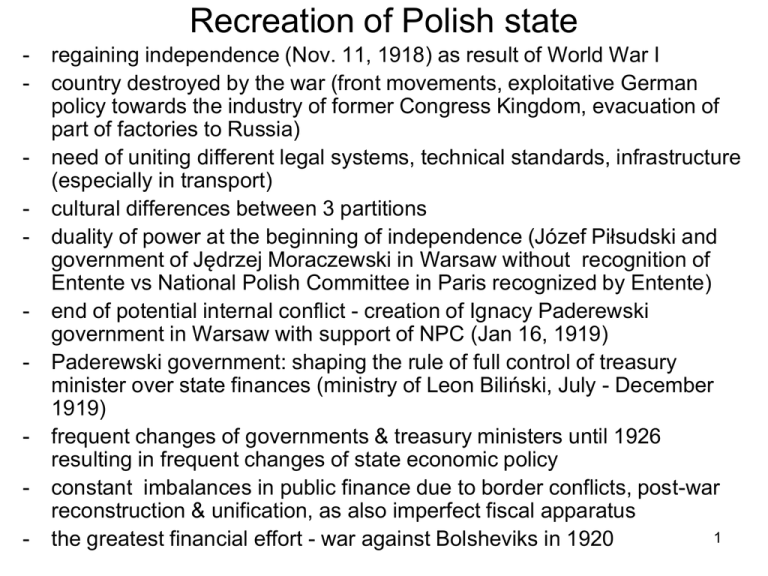
Recreation of Polish state - - - - regaining independence (Nov. 11, 1918) as result of World War I country destroyed by the war (front movements, exploitative German policy towards the industry of former Congress Kingdom, evacuation of part of factories to Russia) need of uniting different legal systems, technical standards, infrastructure (especially in transport) cultural differences between 3 partitions duality of power at the beginning of independence (Józef Piłsudski and government of Jędrzej Moraczewski in Warsaw without recognition of Entente vs National Polish Committee in Paris recognized by Entente) end of potential internal conflict - creation of Ignacy Paderewski government in Warsaw with support of NPC (Jan 16, 1919) Paderewski government: shaping the rule of full control of treasury minister over state finances (ministry of Leon Biliński, July - December 1919) frequent changes of governments & treasury ministers until 1926 resulting in frequent changes of state economic policy constant imbalances in public finance due to border conflicts, post-war reconstruction & unification, as also imperfect fiscal apparatus 1 the greatest financial effort - war against Bolsheviks in 1920 Hyperinflation - - - - money issuance at the end of war – Polish Country Lending Institution (Polska Krajowa Kasa Pożyczkowa, PKKP) – acting in the part of Congress Kingdom occupied by Germans and with German authorities, issuing Polish mark (on parity with German mark) monetary chaos, the need for transitory currency and central bank, hence polonization of PKKP inflation during armed conflicts period (until Treaty of Riga, March 1921) – result of financing budget deficit by paper money 1921-1923 - additional issuance of paper money (over the value of budget deficit) stimulating post-war reconstruction growth of dollar value in Polish marks (%): 1919 – 1123.6, 1920 – 435.8, 1921 – 395.3, 1922 - 509.1, 1923 – 35714.6 (October 1923 alone – 360.6) necessary reforms postponed because of failed attempts of obtaining foreign stabilization credits (USA, UK - but offered conditions unacceptable, especially British) January – June 1923 – Władysław Grabski in ministry of treasure in Władysław Sikorski (centre) and Wincenty Witos (centre-right) governments situation rapidly worsens after Grabski’s dismissal 2 Stabilization - - - Grabski elected prime minister on December 19, 1923, extraordinary prerogatives of issuing government decrees budget reform initially based on property tax (legislation Aug. 1923) and adequate adjustments of tax value (Dec. 1923), later new tax increases, new real estate tax, plans of future sale of part of government property & new tax monopolies; expenditure adjustment – decrease of railway subsidies, job cuts in administration, simultaneously unification of fiscal system in all 3 former partitions, 1924 Budget Act assumed 10% deficit to be financed by bond issue or foreign credit currency reform – money exchange intervention of PKKP on prime minister’s call (Jan. 1924) stopping depreciation of the mark, simultaneously organization of Bank of Poland as joint-stock private bank, independent from government; after successful subscription of BoP shares, start of activity on April 1, 1924 and issue of złoty as new currency on parity with swiss franc, złoty/$ exchange rate 5.18 zł/USD; Polish mark conversion rate 1:1 800 000 consolidation of state-owned commercial banks, creation of Bank of Domestic Economy (Bank Gospodarstwa Krajowego, BGK) – May 1924 1925 Polish-German tariff war, BoP suspends złoty’s convertibility – July 1925, banking crisis in Poland – Sep. 1925, stopped by government’s newly created Fund for Assistance to Credit Institutions; almost 50% drop in złoty’s external value; BoP chairman Stanisław Karpiński denies intervention to Grabski, Grabski’s dismissal (Nov. 13, 1925) 3 Second stabilization - - - - - - new government of Aleksander Skrzyński (paradoxically supported by rivalring Socialists and National Democracy, no peasant parties), Jerzy Zdziechowski (ND) – treasury minister Zdziechowski’s policy based on Gustav Cassel’s idea of exchange rate as relation between price levels of trading partners’ economies, so depreciation could be maintained until external balance was restored budget reforms – temporary salary cuts in administration, export duties on agricultural products (anti-peasant move in fact) improvement of business climate – ca. Feb. 1926, change of foreign capitalists attitude towards Polish economy, closing ties with USA – search for stabilization credits fall of Skrzyński, recreation of highly unpopular coalition of ND with Polish Peasants Party ”Piast”, Piłsudski’s May 1926 coup – beginning of authoritarian system of government first years of authoritarianism (1926-1929) – good business conditions (ended by transmission of American crisis to Europe), helping to raise public support for Piłsudski; period of intense state investment activity (sea port in Gdynia, Silesia-Gdynia railway, nitrate-fertiliser plant near Tarnów – Eugeniusz Kwiatkowski as minister of industry & commerce 1926-1930) and rise of importance of statist modernizers in the ruling elite Anglo-American stabilization credit October 1927 used for change convertibility standard (close to Gold Bullion Standard), not for increase of 4 money in circulation The issue of land reform - - - - common in all Central & Eastern European states rules of reform determined by social & ethnic relations: countries with native landlords and ethnical diversity among peasants (case of Poland) the least radical, countries with landlords of different nationality and native peasants the most radical (Lithuania, Czechoslovakia) measure of radicalism – relation of indemnity payments to land value (ca. 5% in Lithuania – full indemnization in Poland), additional issues of voluntary or obligatory partition of estates (voluntary in Poland) and maximum allowable area of landed estate land reform (legislated Dec. 1925) as result of compromise between Polish Peasant Party (class interests of peasantry) and ND (class interests of landlords) reform executed during authoritarian Piłsudski’s rule – liberal interpretation of legislation – Piłsudski’s will of cutting landlord support for ND 5 Great Depression in Poland - - - - the longest-lasting in Europe (until 1935), the deepest fall of industrial production besides Germany, very sharp fall of agricultural prices while increasing output (so called hunger supply resulting from peasant’s demand for cash) – clear market failure; additional source of intensification of ethnic conlicts in the countryside length of crisis resulting at least partially from Polish participation in Gold Bloc (France, Italy, Belgium Luxembourg, Netherlands, Switzerland) created on July 8,1933 as response to fiasco of London Monetary Conference – strong deflationary effect and loss of international competitiveness; end of Gold Bloc with People’s Front victory in French elections 1936 worsening of economic situation after fall of Credit Anstalt (May 1931) active role of the state – share ownership of bankrupting enterprises (Bank of Domestic Economy, BGK, as main institution of such policy), increasing shares with banks with solvency problems (Bank Handlowy SA in Warsaw), new Acceptance Bank for solving problem of agricultural debts – spontaneous etatization of the economy Work Fund (Fundusz Pracy) – 1933, public works program for unemployed anti-monopolist and anti-cartel policies more autarkic economy due to disruption of international trade system 6 Polish interventionism 1936-1939 - - - Piłsudski’s death (May 12,1935), after that date decomposition of ruling elite new government of Felicjan Sławoj Składkowski (1936-1939), return of Kwiatkowski as deputy prime minister in 1935 economic goals subordinated to worsening international relations: hence focus on development of military industry associated with broader modernization plans; financing partially from French government credits Central Industrial District (COP) – localized in south-central Poland (nowadays south-eastern Poland due to border movements) in order to be relatively safe from invasion from East and West; constructed under auspices of 4-year plan (July 1936-1940) prepared by Kwiatkowski and not synchronised with 6-year plan of Military Modernization (hence relatively strong pressure on long-time goals and infrastructure development); during the war Germans first decapitalize the district, then heavily invest (beyond the reach of the Allies’ bombing airplanes) success of 4-year plan as basis for long-time investment plan 1939-1954 focused on economic convergence between different parts of the country March 1939 – changes in the statute of Bank of Poland allowing for more expansionary monetary policy – too late 7

